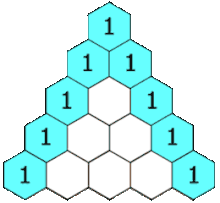1
1 1
1 2 1
1 3 3 1
1 4 6 4 1
1 5 10 10 5 1
The first six rows of Pascal's triangle
Pascal's Triangle is a triangular array . It is named after French mathematician Blaise Pascal , but it was known in China , Persia , and India long before Pascal was born.[ 1]
Pascal's triangle can be made as follows. On the first row , write only the number 1. Then, to get the numbers of following rows, add the number that can be seen above and to the left (if any) and the number above and to the right (if any) to find the new value. For example, the numbers 1 and 3 in the fourth row are added to make 4 in the fifth row.
Each number in the triangle is the sum of the two directly above it. Yang Hui (Pascal's) triangle, as depicted by the Chinese using rod numerals .The triangle displays the coefficients that occur when the binomial
(
a
+
b
)
{\displaystyle (a+b)}
n
th
{\displaystyle n^{\text{th}}}
(
a
+
b
)
0
=
1
(
a
+
b
)
1
=
1
a
+
1
b
(
a
+
b
)
2
=
1
a
2
+
2
a
b
+
1
b
2
(
a
+
b
)
3
=
1
a
3
+
3
a
2
b
+
3
a
b
2
+
1
b
3
(
a
+
b
)
4
=
1
a
4
+
4
a
3
b
+
6
a
2
b
2
+
4
a
b
3
+
1
b
4
{\displaystyle {\begin{array}{lc}(a+b)^{0}=&{\color {Red}{\boldsymbol {1}}}\\(a+b)^{1}=&{\color {Red}{\boldsymbol {1}}}a+{\color {Red}{\boldsymbol {1}}}b\\(a+b)^{2}=&{\color {Red}{\boldsymbol {1}}}a^{2}+{\color {Red}{\boldsymbol {2}}}ab+{\color {Red}{\boldsymbol {1}}}b^{2}\\(a+b)^{3}=&{\color {Red}{\boldsymbol {1}}}a^{3}+{\color {Red}{\boldsymbol {3}}}a^{2}b+{\color {Red}{\boldsymbol {3}}}ab^{2}+{\color {Red}{\boldsymbol {1}}}b^{3}\\(a+b)^{4}=&{\color {Red}{\boldsymbol {1}}}a^{4}+{\color {Red}{\boldsymbol {4}}}a^{3}b+{\color {Red}{\boldsymbol {6}}}a^{2}b^{2}+{\color {Red}{\boldsymbol {4}}}ab^{3}+{\color {Red}{\boldsymbol {1}}}b^{4}\\\end{array}}}
The same triangle can also be expressed using combinations :
1
=
(
0
0
)
1
=
(
1
0
)
1
=
(
1
1
)
1
=
(
2
0
)
2
=
(
2
1
)
1
=
(
2
2
)
1
=
(
3
0
)
3
=
(
3
1
)
3
=
(
3
2
)
1
=
(
3
3
)
1
=
(
4
0
)
4
=
(
4
1
)
6
=
(
4
2
)
4
=
(
4
3
)
1
=
(
4
4
)
{\displaystyle {\begin{array}{c}{\color {Red}{\boldsymbol {1}}}={\binom {0}{0}}\\{\color {Red}{\boldsymbol {1}}}={\binom {1}{0}}\quad \quad {\color {Red}{\boldsymbol {1}}}={\binom {1}{1}}\\{\color {Red}{\boldsymbol {1}}}={\binom {2}{0}}\quad \quad {\color {Red}{\boldsymbol {2}}}={\binom {2}{1}}\quad \quad {\color {Red}{\boldsymbol {1}}}={\binom {2}{2}}\\{\color {Red}{\boldsymbol {1}}}={\binom {3}{0}}\quad \quad {\color {Red}{\boldsymbol {3}}}={\binom {3}{1}}\quad \quad {\color {Red}{\boldsymbol {3}}}={\binom {3}{2}}\quad \quad \quad \quad {\color {Red}{\boldsymbol {1}}}={\binom {3}{3}}\\{\color {Red}{\boldsymbol {1}}}={\binom {4}{0}}\quad \quad {\color {Red}{\boldsymbol {4}}}={\binom {4}{1}}\quad \quad {\color {Red}{\boldsymbol {6}}}={\binom {4}{2}}\quad \quad {\color {Red}{\boldsymbol {4}}}={\binom {4}{3}}\quad \quad {\color {Red}{\boldsymbol {1}}}={\binom {4}{4}}\\\end{array}}}
where
(
n
k
)
=
(
n
)
(
n
−
1
)
…
(
n
−
k
+
1
)
(
k
)
(
k
−
1
)
…
(
1
)
=
n
!
(
k
!
)
⋅
(
n
−
k
)
!
{\displaystyle {\binom {n}{k}}={\frac {(n)(n-1)\ldots (n-k+1)}{(k)(k-1)\ldots (1)}}={\frac {n!}{(k!)\cdot (n-k)!}}}
↑ Willers, Michael (2021). Mathematics: From Algebra to Algorithms, Adventures in Numbers . London, UK: New Burlington Books. p. 130. ISBN 978-1-80242-020-3







